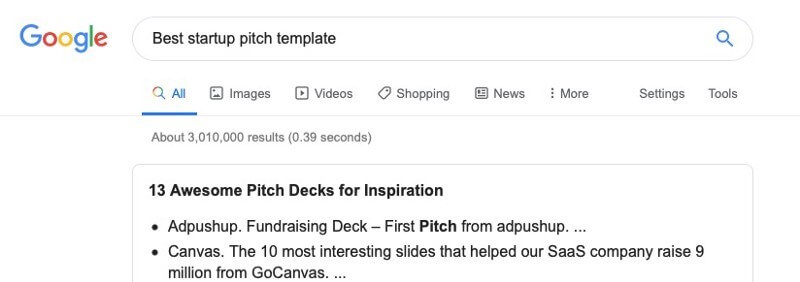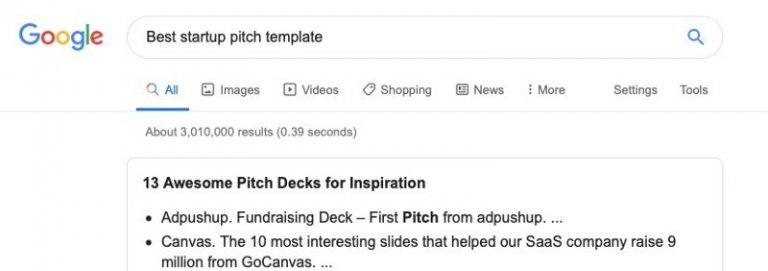What makes a winning startup pitch deck?
By Alan Jones
If you google “Best startup pitch template” you’ll find a gazillion* results which all recommend a very similar structure to follow, which usually runs to 7–10 slides.

*3,010,000 results, to be precise.
Why are so many people all recommending the same pitch deck template?
Because if you ask professional investors — venture capitalists — they’ll tell you they have to review and compare hundreds of startup pitches each month, and the most efficient way to do it is to keep a spreadsheet and score each pitch on the same metrics, which correspond to the subjects of each one of those slides in the standard template. That way, all the VC has to do is look back on a month’s worth of pitches, sort them by metrics, and call in the top three teams for a meeting.
If you’re confident your startup is doing so well that you’re definitely going to score in the top three on those metrics, maybe that’s all you need to do.
But for the rest, it’s important to do more than simply make it easier for a VC to rank you in a spreadsheet.
You have to reach down their optic nerves, right through their rational, calculating forebrain, and grab them by the emotional hindbrain, with both hands, and pull… hard!
What engages the emotional response of a cold, calculating venture capitalist paid good money not to make emotional investment decisions?
Kick-ass story-telling.
Ever since humans evolved the ability to communicate through speech, story-telling and our need to respond to a great story has become hard-wired into our DNA. Even mighty venture capitalists can be rendered powerless in the grasp of a great story.
So what makes a great story?
It needs a beginning and an end, and some kind of moment in the story where a crisis develops and is surmounted — what writers call a “narrative arc”. A narrative arc creates a tension in the mind of the audience that is only released when the story-teller brings the story to the close, making the audience pay attention until the very end.
A story sticks in the memory of your audience when it engages our senses and memories, so great stories always include sentences that begin with, “Take a moment to remember how you felt when you first…” and “Do you love/hate the sound/feel/taste of…”.
Story-telling began as a way of helping people remember important survival information for small groups of early humans: where to look for food and shelter, when to migrate to someplace else, when to hold ’em, and know when to fold ’em when facing off with a competing tribe. So a great story always teaches the audience something about themselves, and about the world around them.
But it doesn’t just deliver the facts. Unless you’re already very passionate about a topic, facts alone usually aren’t as memorable as when they’re folded into a narrative arc.
“They’re paying $49.95 per month”isn’t as memorable as “In the past year we’ve quadrupled the price, and we still see the same conversion rate at $49.95 as we saw at $9.95.”The former is just a fact. The latter is a very compact narrative arc — something changes over time, while something else hasn’t changed at all. The audience will want to know what happens next.
Neuroscience shows that when you tell a great story, the neural activity in the mind of the audience begins to mimic that of the story-teller. It’s literally something you can observe happening in a brain scan.
So if you want to engage the emotions of your audience, it’s not enough to merely retell something you’ve memorised, you’ve got to actually re-live all those emotions and memories yourself. Practice calling them up as you pitch — emotions you’re actually feeling are emotions your audience will feel too, but it takes practice to recall them vividly enough to make them memorable.


